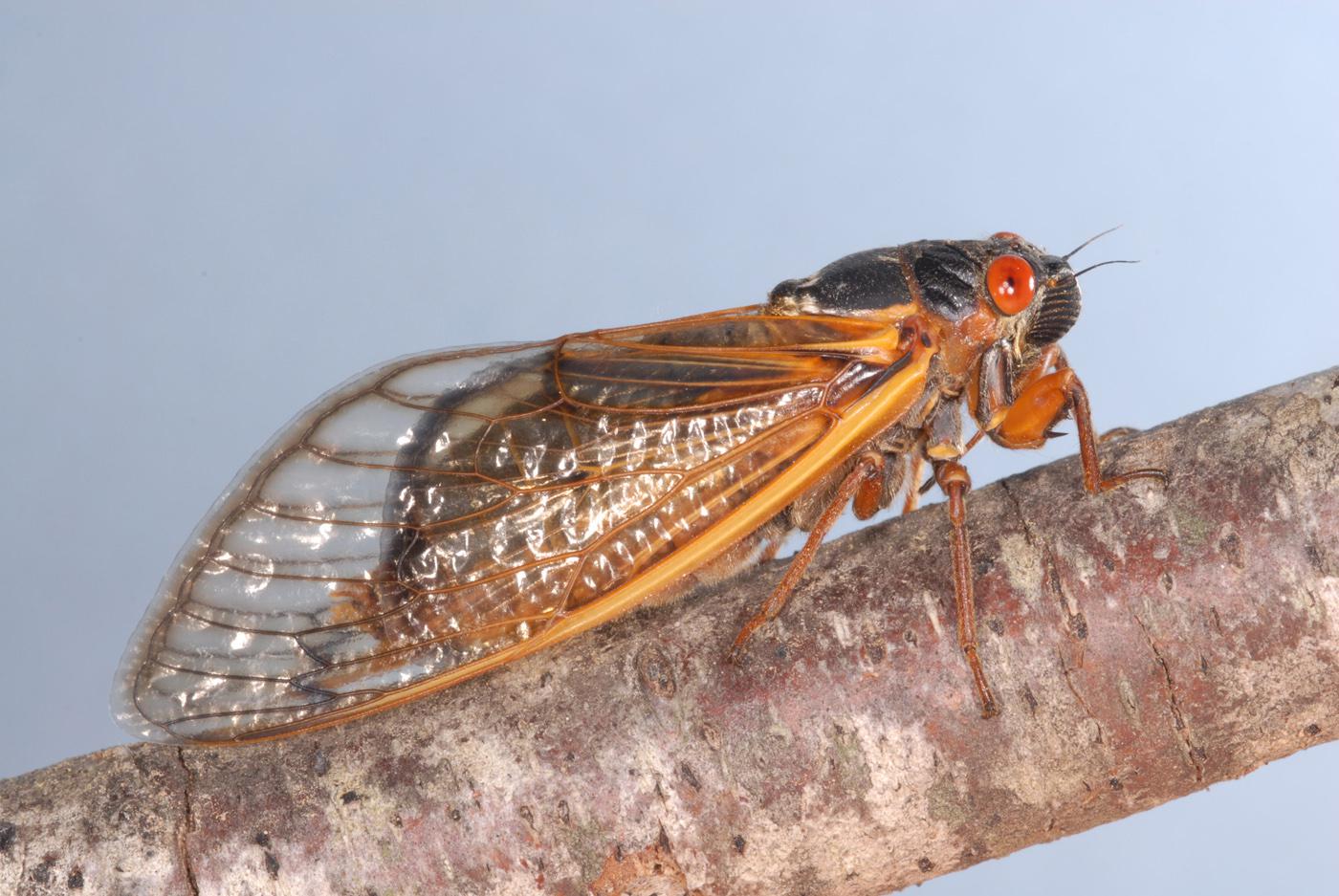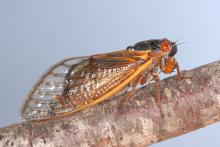Information Possibly Outdated
The information presented on this page was originally released on April 21, 2011. It may not be outdated, but please search our site for more current information. If you plan to quote or reference this information in a publication, please check with the Extension specialist or author before proceeding.
Periodical cicadas will make noisy appearance
MISSISSIPPI STATE – Northeast Mississippi will be noisier than usual later this spring when periodical cicadas make their once-every-13-year appearance.
Blake Layton, entomologist with the Mississippi State University Extension Service, said the periodical cicadas are different from the large, green, annual cicadas that emerge and sound off each summer, usually from mid-June through fall.
“Periodical cicadas are black and orange with red eyes, and they hatch in the thousands,” Layton said. “The singing of the males is loud and long.”
Periodical cicada broods are named, and the group that will emerge in late April and May is known as Brood XIX.
“They have been quietly developing below the ground, living and growing by sucking the sap from the roots of hardwood trees,” Layton said. “This spring, they will emerge as adults to enjoy a few brief weeks in the sunshine.
“The males will sing to attract a female, the females will deposit their eggs, and the adults will die, leaving the eggs of the next generation to carry on the cycle,” he said.
The periodical cicada eggs will hatch in about six weeks, and the tiny nymphs will fall to the ground. They dig into the soil, searching for roots to feed on. They won’t emerge as adults until 2024.
Layton said incomplete records make it difficult to predict exactly where periodical cicadas will appear this year, but they are expected in the area bounded by Interstates 20 and 55.
Records from 1920 indicate that Brood XIX cicadas emerged in Attala, Chickasaw, Choctaw, Clarke, Clay, Itawamba, Jasper, Kemper, Lauderdale, Lee, Leflore, Monroe, Noxubee, Oktibbeha, Prentiss, Rankin, Scott, Union, Webster, Winston and Yazoo counties. Layton said these cicadas may be found in other counties not listed in the 1920 records.
“One of the best ways to verify whether or not periodical cicadas are likely to emerge in your area is to check the archives of your local newspaper,” Layton said. “If the paper ran articles about cicadas in May or June of 1998, they will probably be back this year.”
Cicadas won’t emerge from tilled fields or pastures, pine plantations or hardwood swamps that have experienced prolonged flooding. Well-drained hardwood forests can support more than a million insects per acre. But several broods of periodical cicadas are now extinct because of the clearing of hardwood forests.
There are only three broods of 13-year cicadas in the world, and all occur in Mississippi. Brood XIX, occurring this year, is the largest and covers portions of 15 states. Brood XXII is the smallest, only found in a few Louisiana parishes and a few southwest Mississippi counties. They will emerge in 2014.
Brood XXIII will emerge in 2015 in parts of eight states ranging from Mississippi to southern Illinois. It will occur in more Mississippi counties in four years than Brood XIX will this year. A few areas of the state, such as the extreme southeast portion, have no periodical cicadas. Layton said there are 12 broods of 17-year cicadas in the United States, all found in more northern areas of the country.
Although their black and orange color makes them appear dangerous, cicadas are neither venomous nor poisonous.
“They are eagerly eaten by many birds, reptiles, mammals and even a few people,” Layton said. “The warning colors are a bluff, and periodical cicadas defend themselves by overwhelming numbers. There are just so many cicadas that the predators can’t eat them all.”
The females can, however, cause damage by laying eggs into the pencil-sized twigs of hardwood trees.
“These egg-laying slits sometimes cause the twigs to break, usually about 6 to 12 inches from the end,” Layton said. “This results in hanging, brown, ‘flagged twigs.’ By late May, hardwood trees in areas where cicadas occurred will be brown with flagged twigs.”
Flagged twigs do not cause serious damage to mature hardwoods, but they can harm young shade, fruit and nut trees in home lawns or commercial landscapes, orchards and nurseries. The only protection is to cover the trees with netting that has a mesh small enough to exclude cicadas.
Richard Brown, director of the Mississippi Entomological Museum, said nothing can be done to silence the sound of the cicadas, but many people enjoy the ruckus.
“There are about 2,500 species of cicadas across the world, and some of them are the loudest of all insects, with the sound reaching 120 decibels,” Brown said. “The periodical cicadas individually make a weaker sound, but because of their massive numbers, the resulting sound can be quite a roar.”
The Mississippi Entomological Museum, housed at MSU, has collections of more than 20 species of cicadas from Mississippi, including all three broods of 13-year cicadas found in the state. Included in this collection are specimens of five generations of Brood XIX, the oldest dating back to 1907.


